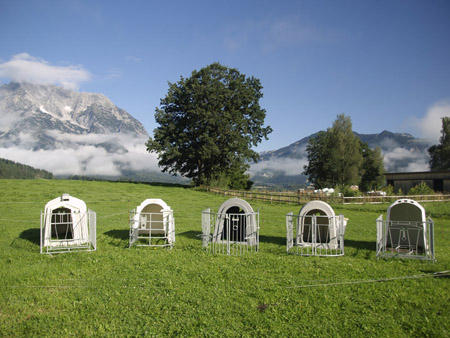For this reason, a comparison test was carried out at the HBLFA Raumberg-Gumpenstein in collaboration with the “progressive farmer” to show the strengths and weaknesses of the individual igloos.
In a comparison test, 5 igloos from different manufacturers were tested. In addition to the technical data and the light and temperature conditions, particular emphasis was placed on animal welfare (risk of injury) and user-friendliness. If problems arose, the companies were contacted immediately. For the most part, the reaction to this was positive; the companies themselves are interested in continually improving their products. In this way, improvements could be made together that reduced the risk of injury to people and animals (some deficiencies had already been remedied by the companies themselves in advance!).
Basically, keeping calves in calf igloos is a good and inexpensive alternative to converting a stable. They are generally simple to use and easy to clean and disinfect, thus reducing the infection pressure on the newborn calf. However, there are a few things to consider when purchasing and setting up the igloos.
- For example, it is required that the outer surface of the igloos be white if possible but at least light gray or light beige. Dark igloos lead to excessive heating inside.
- The surface of the igloos must be smooth so that it can be cleaned without problems.
- In order to eliminate the risk of strangulation, the distances between the bars of the fence must not be more than 10 cm, although a vertical arrangement of the bars is preferable.
- The connection between the igloo and the run must be designed in such a way that no calf can slip its head through the gap - there is also a risk of strangulation here.
- The igloos should be set up under an overhang or a canopy; this not only provides better weather protection for the calves but also provides more pleasant working conditions for the carer.
- The opening of the igloo must face away from the weather side - in summer it faces north and in summer it faces east or southeast. This is particularly important to take into account when installing outdoors.
- If you place the igloos under the eaves, this should, if possible, be done in the shade on the north or east side of stables in summer and on the south side of stables in winter.
Further information:
Calf igloo final report July 2009
Lecture “Keeping calves in calf igloos”
A report about this has also been published in the magazine "The Progressive Farmer", which you can visit using the following link:
http://www.landwirt.com/rinderberichte/Kaelberiglus,1,5-Iglus-im-Vergleich.html
Further information on project management can be found in the database for research and sustainable development (Dafne) -> Link







